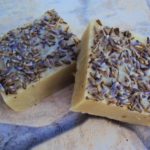
Homemade Shampoo Bar Recipe
Homemade DIY shampoo bar recipe with lavender and clay. This is my favorite soap that gets my hair clean and shiny. Are you ready to switch to a no-poo method and try to make your own shampoo bar at home?
Servings 4 soaps
Ingredients
OILS & FATS
- 90 g olive oil
- 78 g coconut oil
- 36 g shea butter
- 36 g castor oil
LYE SOLUTION
- 70 g cold water
- 34.27 g sodium hydroxide
ESSENTIAL OILS
- 4.1 g rosemary oil
- 6.2 g lavender oil
ADDITIVES
- 2 tsp clay + a little water
EQUIPMENT
- 1 stainless steel pot to melt the fats
- 1 medium-sized plastic cup for weighing the sodium hydroxide, empty and clean
- 1 heat-resistant plastic container for mixing the lye liquid
- 1 mg-accurate scale for weighing the sodium hydroxide
- 1 normal kitchen scale for weighing the fats/oils
- 2 mixing spoons made of plastic
- 1 food thermometer
- 1 rubber spatula
- 1 hand blender without aluminium parts
- 1 pair of rubber gloves
- 1 protective goggles important!
- work clothes e.g. apron, long sleeves, and trousers
- newspaper for covering the working surface
- 1 kitchen roll
- 1 mold for the soap silicone molds work best
Instructions
- Cover the work surface with newspaper and provide ventilation in the room.
- In a small bowl, mix the clay with a tiny bit of water (as little as possible) and let it sit.
- Wear rubber gloves, put on protective goggles.
- Weigh the sodium hydroxide in a heat-resistant cup, use the mg-accurate scale.
- Weigh the water in a separate cup.
- Now, carefully and slowly pour the weighed sodium hydroxide into the cold water (preferably near a window) and stir gently until the sodium hydroxide has completely dissolved.IMPORTANT: Always put the sodium hydroxide in the water, never the other way around! Do not inhale the resulting vapors. The liquid quickly becomes very hot and the cup should be placed in a cold water bath in the sink, to cool the lye solution.
- Meanwhile, weigh the fats (coconut oil and shea butter) and melt them in a warm water bath (or in a double boiler). Weigh the other two oils (olive oil, castor oil) and add them to the fats.
- Wait until both the cup of the lye solution and the pot of the fats/ oils are hand warm and have about the same temperature (30-45 degrees C).
- Carefully pour the lye solution into the fats/ oils (you should still wear your goggles and gloves) and mix carefully with a hand blender (immersion blender).
- The mixture becomes a little cloudy after a short time and starts to thicken. Turn the hand blender off after one minute and add the essential oils and the clay to the mixture.
- Continue stirring until the liquid soap has the consistency of pudding. This can happen after one minute or only after 5 minutes. Do not stir too long though, otherwise, the mixture becomes quickly too thick.
- Pour the liquid soap into the mold, tap the mold onto your work surface to remove any air bubbles.
- Cover the mold with a plastic foil and gently wrap a towel around the mold so that the soap comes into the "gel stage" (this accelerates the saponification process).
- You can get rid of your goggles now and start making the dishes (keep wearing your gloves though).
- The soap can be cut and shaped after 24 hours.
- Patience is required now because the soap has to "mature" and dry in an airy place for at least 4-6 weeks, only then it can be used! The longer the soap sits/ dries, the milder it becomes. Also, a well-"ripened" soap will be used up more slowly than a young soap. So be patient!
Notes
SAFETY MEASURES:
- Wear protective clothing (long sleeves and trousers)
- Put on gloves
- Wear protective goggles when working with the lye